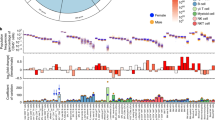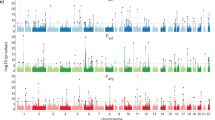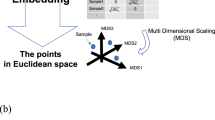Abstract
CD4–CD8 ratio is an important diagnostic measure of immune system functioning. In particular, CD4–CD8 ratio predicts the time taken for progression of HIV infection to acquired immune deficiency syndrome (AIDS) and the long-term survival of AIDS patients. To map genes that regulate differences between healthy individuals in CD4–CD8 ratio, we typed 757 highly polymorphic microsatellite markers at an average spacing of ∼5 cM across the genome in 405 pairs of dizygotic twins at ages 12, 14 and 16. We used multipoint variance components linkage analysis to test for linkage between marker loci and CD4–CD8 ratio at each age. We found suggestive evidence of linkage on chromosome 11p in 12-year-old twins (LOD=2.55, P=0.00031) and even stronger evidence of linkage in the same region at age 14 (LOD=3.51, P=0.00003). Possible candidate genes include CD5 and CD6, which encode cell membrane proteins involved in the positive selection of thymocytes. We also found suggestive evidence of linkage at other areas of the genome including regions on chromosomes 1, 3, 4, 5, 6, 12, 13, 15, 17 and 22.
This is a preview of subscription content, access via your institution
Access options
Subscribe to this journal
Receive 6 digital issues and online access to articles
$119.00 per year
only $19.83 per issue
Buy this article
- Purchase on Springer Link
- Instant access to full article PDF
Prices may be subject to local taxes which are calculated during checkout

Similar content being viewed by others
References
Amadori A, Zamarchi R, De Silvestro G et al. Genetic control of the CD4/CD8 T-cell ratio in humans [see comments]. Nat Med 1995; 1: 1279–1283.
Pedersen C, Dickmeiss E, Gaub J et al. T-cell subset alterations and lymphocyte responsiveness to mitogens and antigen during severe primary infection with HIV: a case series of seven consecutive HIV seroconverters. Aids 1990; 4: 523–526.
Baillargeon J, Grady J, Borucki MJ . Immunological predictors of HIV-related survival. Int J STD AIDS 1999; 10: 467–470.
Drabick JJ, Williams WJ, Tang DB, Sun W, Chung RC . CD4 lymphocyte decline and survival in human immunodeficiency virus infection. The Military Medical Consortium for Applied Retroviral Research. AIDS Res Hum Retroviruses 1992; 8: 2039–2047.
Taylor JM, Fahey JL, Detels R, Giorgi JV . CD4 percentage, CD4 number, and CD4:CD8 ratio in HIV infection: which to choose and how to use. J Acquir Immune Defic Syndr 1989; 2: 114–124.
Evans DM, Frazer IH, Martin NG . Genetic and environmental causes of variation in basal levels of blood cells. Twin Res 1999; 2: 250–257.
Kraal G, Weissman IL, Butcher EC . Genetic control of T-cell subset representation in inbred mice. Immunogenetics 1983; 18: 585–592.
Azzam HS, Grinberg A, Lui K, Shen H, Shores EW, Love PE . CD5 expression is developmentally regulated by T cell receptor (TCR) signals and TCR avidity. J Exp Med 1998; 188: 2301–2311.
Zhou XY, Yashiro-Ohtani Y, Toyo-Oka K et al. CD5 costimulation up-regulates the signaling to extracellular signal-regulated kinase activation in CD4+CD8+ thymocytes and supports their differentiation to the CD4 lineage. J Immunol 2000; 164: 1260–1268.
Tarakhovsky A, Kanner SB, Hombach J et al. A role for CD5 in TCR-mediated signal transduction and thymocyte selection. Science 1995; 269: 535–537.
Osorio LM, Rottenberg M, Jondal M, Chow SC . Simultaneous cross-linking of CD6 and CD28 induces cell proliferation in resting T cells. Immunology 1998; 93: 358–365.
Singer NG, Fox DA, Haqqi TM et al. CD6: expression during development, apoptosis and selection of human and mouse thymocytes. Int Immunol 2002; 14: 585–597.
Evans DM . The genetics of blood cell concentrations. Unpublished PhD thesis, University of Queensland, Brisbane, Australia, 2003.
Hall MA, Norman PJ, Thiel B et al. Quantitative trait loci on chromosomes 1, 2, 3, 4, 8, 9, 11, 12, and 18 control variation in levels of T and B lymphocyte subpopulations. Am J Hum Genet 2002; 70: 1172–1182.
Roberts SB, MacLean CJ, Neale MC, Eaves LJ, Kendler KS . Replication of linkage studies of complex traits: an examination of variation in location estimates. Am J Hum Genet 1999; 65: 876–884.
Aitken JF, Pfitzner J, Battistutta D, O'Rourke PK, Green AC, Martin NG . Reliability of computer image analysis of pigmented skin lesions of Australian adolescents. Cancer 1996; 78: 252–257.
McGregor B, Pfitzner J, Zhu G et al. Genetic and environmental contributions to size, color, shape, and other characteristics of melanocytic naevi in a sample of adolescent twins. Genet Epidemiol 1999; 16: 40–53.
Zhu G, Duffy DL, Eldridge A et al. A major quantitative-trait locus for mole density is linked to the familial melanoma gene CDKN2A: a maximum-likelihood combined linkage and association analysis in twins and their sibs. Am J Hum Genet 1999; 65: 483–492.
Miller SA, Dykes DD, Polesky HF . A simple salting out procedure for extracting DNA from human nucleated cells. Nucleic Acids Res 1988; 16: 1215.
Zhu G, Evans DM, Duffy DL et al. A genome scan for eye colour in 539 twin families. Twin Res 2004; 7: 197–210.
Amos CI . Robust variance-components approach for assessing genetic linkage in pedigrees. Am J Hum Genet 1994; 54: 535–543.
Almasy L, Blangero J . Multipoint quantitative-trait linkage analysis in general pedigrees. Am J Hum Genet 1998; 62: 1198–1211.
Eaves LJ, Neale MC, Maes H . Multivariate multipoint linkage analysis of quantitative trait loci. Behav Genet 1996; 26: 519–525.
Fulker DW, Cherny SS . An improved multipoint sib-pair analysis of quantitative traits. Behav Genet 1996; 26: 527–532.
Lange K, Westlake J, Spence MA . Extensions to pedigree analysis. III. Variance components by the scoring method. Ann Hum Genet 1976; 39: 485–491.
Abecasis GR, Cherny SS, Cookson WO, Cardon LR . Merlin—rapid analysis of dense genetic maps using sparse gene flow trees. Nat Genet 2002; 30: 97–101.
Dot D, Miro J, Fuentes-Arderiu X . Biological variation of the leukocyte differential count quantities. Scand J Clin Lab Invest 1992; 52: 607–611.
Self SG, Liang K . Asymptotic properties of maximum likelihood estimators and likelihood ratio tests under nonstandard conditions. J Amer Stat Assoc 1987; 82: 605–610.
Williams JT, Blangero J . Power of variance component linkage analysis to detect quantitative trait loci. Ann Hum Genet 1999; 63: 545–563.
Allison DB, Neale MC, Zannolli R, Schork NJ, Amos CI, Blangero J . Testing the robustness of the likelihood-ratio test in a variance-component quantitative-trait loci-mapping procedure. Am J Hum Genet 1999; 65: 531–544.
Blangero J, Williams JT, Almasy L . Robust LOD scores for variance component-based linkage analysis. Genet Epidemiol 2000; 19 (Suppl 1): S8–S14.
Acknowledgements
We thank Ann Eldridge, Marlene Grace and Anjali Henders for assistance and the twins, their siblings and their parents for their cooperation. Collection of phenotypes and DNA samples was supported by grants from the Queensland Cancer Fund, the Australian National Health and Medical Research Council (950998, 981339 and 241944) and the US National Cancer Institute (CA88363) to Dr Nick Hayward. The genome scans were supported by the Australian NHMRC's Program in Medical Genomics and funding from the Center for Inherited Disease Research (Director, Dr Jerry Roberts) at Johns Hopkins University to Dr Jeff Trent.
Author information
Authors and Affiliations
Corresponding author
Rights and permissions
About this article
Cite this article
Evans, D., Zhu, G., Duffy, D. et al. A major quantitative trait locus for CD4–CD8 ratio is located on chromosome 11. Genes Immun 5, 548–552 (2004). https://doi.org/10.1038/sj.gene.6364126
Received:
Revised:
Accepted:
Published:
Issue Date:
DOI: https://doi.org/10.1038/sj.gene.6364126
Keywords
This article is cited by
-
Causative factors of liver fibrosis in HIV-infected patients. A single center study
BMC Gastroenterology (2020)
-
Monozygotic twins with GATA2 deficiency: same haploidentical-related donor, different severity of GvHD
Bone Marrow Transplantation (2017)
-
Combined use of etanercept and MTX restores CD4+/CD8+ ratio and Tregs in spleen and thymus in collagen-induced arthritis
Inflammation Research (2012)
-
Impact of MHC class II polymorphism on blood counts of CD4+ T lymphocytes in macaque
Immunogenetics (2011)
-
A study of 82 extended HLA haplotypes in HFE-C282Y homozygous hemochromatosis subjects: relationship to the genetic control of CD8+ T-lymphocyte numbers and severity of iron overload
BMC Medical Genetics (2006)



